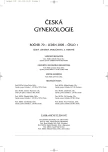New Options in Pharmacological Treatment of Urge Urinary Incontinence in Women
Nové možnosti v medikamentózní léčbě urgentní inkontinence moči u žen
Cíl studie:
Cílem tohoto článku je krátký aktuální přehled současné medikamentózní léčby urgentní inkontinence moči u žen.
Typ práce:
Souhrnný přehled.
Název a sídlo pracoviště:
Gynekologicko-porodnická klinika VFN a 1. LF UK v Praze.
Výsledky:
Urgentní inkontinence je definována podle ICS (International Continence Society) jako nechtěný únik moči při imperativním nucení na moč. Urgentní inkontinence moči je často způsobena detruzorovou instabilitou (motorickým typem urgentní inkontinence moči), kde nestabilita močového měchýře nemůže být prokázána klinicky, ale cystometrickým vyšetřením. Senzorická urgentní inkontinence moči je nechtěný únik moči sdružený s urgencí a silným nucením na močení způsobený hypersenzitivitou receptorů umístěných v močovém měchýři a uretře. Základní léčbou tohoto typu inkontinence moči je konzervativní léčba. Hlavní dva typy konzervativní léčby jsou – ovlivnění chování močového měchýře a medikamentózní léčba. Nejúspěšnější při léčbě urgentní inkontinence je léčba medikamentózní. Léky s anticholinergním či s anticholinergním spolu se spazmolytickým efektem jsou základní medikamentózní léčbou tohoto stavu, ačkoli účinnost těchto preparátů je limitována nedostatečným selektivním zaměřením na močový měchýř, což způsobuje často nepříjemné vedlejší účinky (sucho v ústech, zácpu, mlhavé vidění atd.). Z těchto důvodů byl vyvinut antimuskarinový přípravek tolterodin cíleně zaměřený na léčbu urgentní inkontinence moči. Působí cíleně a dlouhodobě na močový měchýř a jen málo ovlivňuje slinné žlázy.
Klíčová slova:
močová inkontinence žen, urgentní inkontinence moči, tolterodin
Authors:
A. Martan
Authors‘ workplace:
Gynekologicko-porodnická klinika VFN a 1. LF UK, Praha, přednosta prof. MUDr. A. Martan, DrSc.
Published in:
Ceska Gynekol 2005; 70(1): 3-8
Category:
Original Article
Overview
Objective:
The aim of this paper is to provide a brief update review of current pharmacological agents used to treat women with urge incontinence.
Design:
Review article.
Settings:
Gynecological and Obstetric Clinic, 1. LF UK and VFN, Prague.
Results:
Urge urinary incontinence is the condition characterized by the involuntary loss of urine accompained by a strong desire to void. Urge incontinence is often due to detrusor instability, although the instability of the detrusor bladder muscle cannot be demonstrated clinically but through cystomery. Sensory urge incontinence is the involuntary loss of urine associated with urgency and a strong desire to void urine immediately due to the hypersensitivity of the bladder and urethral sensory receptors. The mainstay treatment for this common form of incontinence is conservative treatment. There are two forms of conservative treatment: behavioural techniques and pharmacotherapy. The urge urinary incontinence is most successfully treated by a drug therapy. Anticholinergic drugs and anticholinergic antispasmodic drugs are the primary pharmacologic treatment for this condition, although the usefulness of this agent has been limited by a lack of selectivity for the bladder, which gives rise to frequent, bothersome side effect (dry mouth, constipation, blurred vision, etc.) For these reasons, tolterodine was developed as the first antimuscarinic agent specifically targeted for the treatment of the urge urinary incontinence.
This agent has demonstrated a bladder-selective profile in vivo, leading to a more pronunced and longer lasting effect on the bladder than on salivation in humans.
Key words:
female urinary incontinence, urge urinary incontinence, tolterodine
Labels
Paediatric gynaecology Gynaecology and obstetrics Reproduction medicineArticle was published in
Czech Gynaecology

2005 Issue 1
Most read in this issue
- Abdominal hysterectomy – Risk Factor in Development of Urinary Incontinence? Results of a Questionnaire Study
- Risk Factors of the 3rd and 4th Degree Tear during Delivery
- Syndrome of Pseudomyxoma Peritonei – Description of Three Cases and Survey of the Problem
- Contribution of Doppler Examination in Pregnancy at Risk of Alloimune Fetus Anemia
